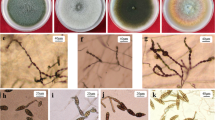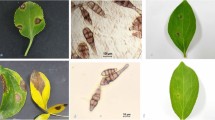Abstract
Severe lesions along with black spots on tea leaves were observed in the commercial tea plantations located in Chongqing district of China during the April to July of 2015. The pathogens isolated from diseased tea leaves matched the morphological characteristics of Alternaria alternata that were rarely found on tea plant [Camellia sinensis (L.) O. Kuntze] in all the tea-growing countries worldwide. The characteristics of A. alternata were further confirmed by both pathogenicity tests and multi-gene phylogenetic analyses derived from internal transcribed spacer (ITS), glyceraldehyde-3-phosphate dehydrogenase (GAPDH) and beta-tubulin (β-tubulin). The combination of ITS, GAPDH and β-tubulin was more useful for delimitation in the genus Alternaria than any single gene region. Pathogenicity tests conducted on healthy tea leaves showed typical leaf spot symptoms, confirming the role of all the A. alternata isolates as the causal agent of leaf spot disease on tea plants.






Similar content being viewed by others
References
Abkhoo J, Sabbagh SK (2014) Evidence of Alternaria alternata causing leaf spot of Aloe vera in Iran. J Phytopathol 162:516–518
Andersen B, Kroger E, Roberts RG (2002) Chemical and morphological segregation of Alternaria arborescens, A. infectoria and A. tenuissima species groups. Mycol Res 106:170–182
Bernadovičová S, Ivanová H (2011) Hyphomycetes and coelomycetes fungi isolated from affected leaves and twigs of cherry laurel trees. Folia Oecologica 38:137–145
Chakraborty BN, Das-Biswas R, Sharma M (2006) Alternaria alternata – a new foliar fungal pathogen of tea in north Bengal, India. Plant Pathol 55:303
Chen WQ, Zhang TY (1997) Two new species of Alternaria from China. Mycol Res 101:1257–1258
Chen YJ, Qiao WJ, Zeng L, Shen DH, Liu Z, Wang SH, Tong HR (2017) Characterization, pathogenicity and phylogenetic analyses of Colletotrichum species associated with Brown blight disease on Camellia sinensis in China. Plant Dis 101:1022–1028
Coates L, Johnson G (1997) Postharvest diseases of fruit and vegetables. In: Brown JF, Ogle HJ (eds) Plant pathogens and plant diseases. Rockvale publications, Armidale, Australia, pp 533–548
Conrath U, Linke C, Jeblick W, Geigenberger P, Quick WP, Neuhaus HE (2003) Enhanced resistance Phytophthora infestans and Alternaria solani in leaves and tubers, respectively, of potato plants with decreased activity of the plastidic ATP/ADP transporter. Planta 217:75–83
Cota BB, Rosa LH, Caligiorne RB, Rabello ALT, Almeida Alves TM, Rosa CA, Zani CL (2008) Altenusin, a biphenyl isolated from the endophytic fungus Alternaria sp., inhibits trypanothione reductase from Trypanosoma cruzi. FEMS Microbiol Lett 285:177–182
Ellis MB (1971) Dematiaceous Hyphomycetes. Commonwealth Mycological Institute, Kew, 608ff
Ellis MB (1976) More Dematiaceous Hyphomycetes. Commonwealth Mycological Institute, Kew, 507ff
Hong SG, Maccaroni M, Figuli PJ, Belisario A, Pryor BM (2006) Polyphasic classification of Alternaria isolated from hazelnut and walnut fruit in Europe. Mycol Res 104:1312–1321
Kimura M (1980) A simple method for estimating evolutionary rate of base substitutions through comparative studies of nucleotide sequences. J Mol Evol 16:111–120
Lawrence DP, Gannibal PB, Dugan FM, Pryor BM (2014) Characterization of Alternaria isolates from the infectoria species-group and a new taxon from Arrhenatherum, Pseudoalternaria arrhenatheria sp. nov. Mycol Prog 13:257–276
O’Donnell K, Cigelnik E (1997) Two divergent intragenomic rDNA ITS2 types within a monophyletic lineage of the fungus Fusarium are nonorthologous. Mol Phylogenet Evol 7:103–116
Pelaez F, Collado J, Arenal F, Basilio A, Cabello A, Matas MTD, García JB, Del Val AG, Gonzalez V, Gorrochategui J, Hernandez IM, Platas G, Vicente F (1998) Endophytic fungi from plants living on gypsum soils as a source of secondary metabolites with antimicrobial activity. Mycol Prog 102:755–761
Queiroz FM, Muniz M, de FS, Menez M (2001) Alternaria brasiliensis sp. nov., a leaf pathogen on Phaseolus vulgaris. Mycopathologia 150:61–65
Saitou N, Nei M (1987) The neighbor-joining method: a new method for reconstructing phylogenetic trees. Mol Biol Evol 4:406–425
Simmons EG (1992) Alternaria taxonomy: current status, viewpoint, challenge. In: Chelkowski J, Viskonti A (eds) Alternaria: biology, plant diseases and metabolites. Elsevier, Amsterdam, pp 1–35
Simmons EG (1993) Alternaria themes and variations (54–62). Mycotaxon 46:171–199
Simmons EG (1995) Alternaria themes and variations (112–144). Mycotaxon 55:55–163
Simmons EG (2000) Alternaria themes and variations (244–286). Mycotaxon 75:1–115
Tamura K, Stecher G, Peterson D, Lewis PO (2013) MEGA6: molecular evolutionary genetics analysis version 6.0. Mol Biol Evol 30:2725–2729
Templeton MD, Rikkerink EH, Solon SL, Crowhurst RN (1992) Cloning and molecular characterization of the glyceraldehyde-3-phosphate dehydrogenase-encoding gene and cDNA from the plant pathogenic fungus Glomerella cingulata. Gene 122:225–230
Than PP, Jeewon R, Hyde KD, Pongsupasamit S, Mongkolporn O, Taylor PWJ (2008) Characterization and pathogenicity of Colletotrichum species associated with anthracnose on chilli (Capsicum spp.) in Thailand. Plant Pathol 57:562–572
Visconti A, Sibilia A (1994) Alternaria toxins. In: Miller JD, Trenholm HL (eds) Mycotoxins in grain. Compounds other than aflatoxins. Eagan press, St. Paul, pp 315–358
Wang XF, Li ZA, Tang KZ, Zhou CY, Yi L (2010) First report of Alternaria Brown spot of Citrus caused by Alternaria alternata in Yunnan Province, China. Plant Dis 94:375
White TJ, Bruns T, Lee S, Taylor J (1990) Amplification and direct sequencing of fungal ribosomal RNA genes for phylogenetics. In: Innis MA, Gelfand DH, Sninsky JJ, White TJ (eds) PCR protocols: a guide to methods and amplifications. San Diego. Academic Press, USA, pp 315–322
Woudenberg JHC, Seidl MF, Groenewald JZ, de Vries M, Stielow JB, Thomma BPHJ, Crous PW (2015) Alternaria section Alternaria: species, formae speciales or pathotypes? Stud Mycol 82:1–21
Zhou LX, Xu WX (2014) First report of Alternaria alternata causing leaf spots of tea (Camellia sinensis) in China. Plant Dis 98:697
Acknowledgements
This work was supported by the National Natural Science Foundation of China (NSFC) (31700607), the Natural Science Foundation Project of CQ CSTC (cstc2015jcyjA80019) and the Fundamental Research Funds for the Central Universities (XDJK2017C045, XDJK2016C061 and SWU115057) for financial support.
Author information
Authors and Affiliations
Corresponding author
Rights and permissions
About this article
Cite this article
Chen, YJ., Meng, Q., Zeng, L. et al. Phylogenetic and morphological characteristics of Alternaria alternata causing leaf spot disease on Camellia sinensis in China. Australasian Plant Pathol. 47, 335–342 (2018). https://doi.org/10.1007/s13313-018-0561-0
Received:
Accepted:
Published:
Issue Date:
DOI: https://doi.org/10.1007/s13313-018-0561-0




